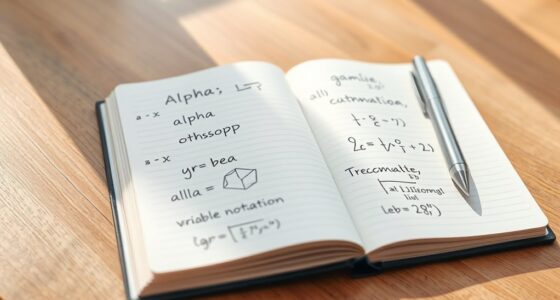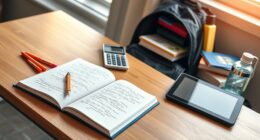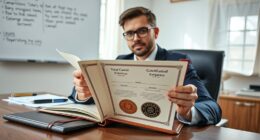To capture everything during lectures or discussions, combine handwritten and digital note-taking methods. Use rapid handwriting for quick sketches, diagrams, and key points, then transfer or supplement these notes digitally with links, images, and audio for thoroughness. Developing abbreviations and visual cues helps you keep pace with spoken content. Combining these approaches guarantees you don’t miss details while staying organized and efficient. Keep exploring to discover how to tailor your approach for maximum effectiveness.
Key Takeaways
- Use a hybrid approach: take handwritten notes for quick capture and transfer or enhance digitally for organization.
- Incorporate multimedia elements like images, audio, and links in digital notes to encompass all content types.
- Develop systematic shorthand and abbreviations to keep pace with fast information during note-taking.
- Utilize stylus-supported apps to combine natural handwriting with digital flexibility.
- Regularly review and organize notes to ensure all details are accurately captured and retained.

Effective note-taking is essential for retaining information and staying organized during lectures, meetings, or personal study sessions. When you aim to capture everything, it’s important to leverage the right methods that suit your style and the context. One effective approach involves combining digital tools with traditional handwritten techniques. Digital tools, like note-taking apps on tablets or laptops, allow you to type quickly, organize notes effortlessly, and search through large volumes of information instantly. They’re especially useful during fast-paced lectures or meetings where speed matters. You can also insert images, links, and audio recordings, which help enrich your notes and make sure no detail is missed. Handwritten techniques, on the other hand, offer the advantage of better memory retention and understanding. Writing by hand forces you to process information more deeply, helping you internalize concepts more effectively. Using a pen and paper allows for quick sketches, diagrams, and annotations that can be more intuitive than digital equivalents. The key is knowing when to switch between these methods. For capturing complex ideas or detailed diagrams, handwritten notes might be more effective because they allow for freeform expression and immediate visuals. Meanwhile, for summarizing key points or consolidating information, digital tools can help you organize and review your notes swiftly. Incorporating visual learning techniques can further enhance your ability to grasp and remember complex information. To truly capture everything, you might consider a hybrid approach. During a lecture, start with handwritten notes to jot down key points and quick sketches. Afterwards, transfer or supplement these notes digitally, adding hyperlinks, clarifications, or multimedia elements. Many apps now support stylus input, making it easy to draw diagrams and write naturally on a screen. This way, you get the benefits of both worlds—speed and flexibility from digital tools, and depth and retention from handwriting. Additionally, developing a systematic shorthand or abbreviations can help you keep pace with fast speech and record more information without missing critical details. Consistently reviewing and organizing your notes, whether digital or handwritten, ensures you retain everything important. Ultimately, the best method is the one that fits your learning style and allows you to capture and review all relevant information efficiently. Combining digital tools with handwritten techniques creates a thorough system that maximizes your ability to remember and understand everything discussed.
Frequently Asked Questions
Can Note-Taking Methods Be Personalized Effectively?
You can definitely personalize your note-taking methods effectively. Using techniques like mind mapping helps you organize ideas visually, while color coding highlights key points and makes information easier to find. By combining these strategies with your unique learning style, you create a system that works best for you. Personalization boosts retention and engagement, making note-taking more efficient and tailored to how you process information.
How Do I Choose the Best Method for My Needs?
Choosing the best method is like planting a garden; you need to find the right tools. Think of mind mapping as your trellis, helping ideas grow and connect, while color coding acts as vibrant flowers that highlight important points. Experiment with these techniques, see which feels natural and keeps you engaged. Adapt your approach as your needs evolve, and you’ll cultivate a note-taking style that’s uniquely yours.
Are Digital or Analog Notes More Reliable?
When deciding between digital and analog notes, consider reliability. Digital storage offers the advantage of note synchronization across devices, ensuring your notes are always accessible and backed up. However, digital files can be vulnerable to technical issues or hacking. Analog notes, on the other hand, are immune to digital failures but lack automatic backup. Choose based on your need for seamless access versus resilience, keeping in mind your preferred method of note management.
How Can I Review Notes Efficiently?
Sure, because flipping through endless notes is everyone’s favorite pastime. To review efficiently, try mind mapping to connect ideas and create visual summaries that make recall easier. Highlight key points and use colors to distinguish concepts. Skim through summaries first, then delve into details for clarity. This way, you save time, avoid chaos, and actually understand what you’ve written—no more drowning in a sea of notes.
What Tools Enhance Comprehensive Note-Taking?
To enhance extensive note-taking, you should explore tools like digital apps that support mind mapping and color coding. Mind mapping helps you visualize connections, making complex ideas easier to grasp. Color coding highlights key points and organizes information for quick review. These tools make your notes more detailed and accessible, ensuring you capture everything important while making future reviews more efficient and engaging.
Conclusion
By adopting the right note-taking method, you can capture every detail like a sponge soaking up water, ensuring no idea slips through the cracks. Whether it’s the structured Cornell or the free-flowing mind map, these techniques turn chaos into clarity. Remember, your notes become the blueprint of your knowledge universe—vast, detailed, and unstoppable. So, choose your method wisely and watch your understanding explode like fireworks, illuminating your path to success with every page you fill.










